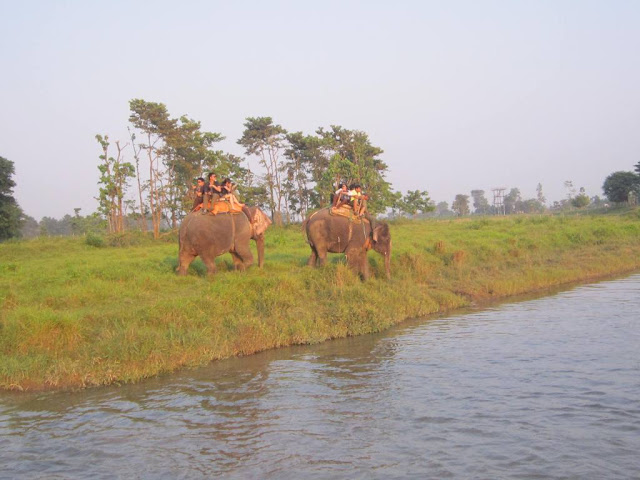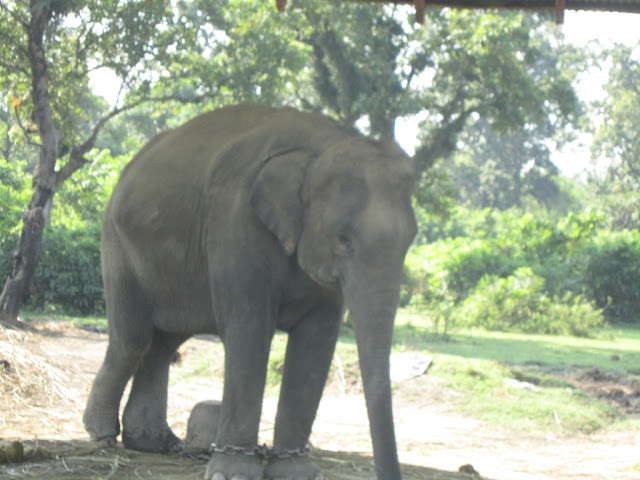- About Chitwan National Park
 |
| Chitwan National Park ( jungle safari in Nepal ) |
Nepal first and Famous National Park is The Chitwan National Park (CNP) is a world heritage property, and it also contains a Ramsar Site – Beeshazari Tal in its buffer zone. It suited in low land of inner terai. Covering an area of 932 Sq Km.
It is a rich natural area in the Terai, the subtropical southern part of Nepal. A total of 68 species of mammals, 544 species of birds, 56 species of herpetofauna and 126 species of fish have been recorded in the park. The park is especially renowned for its protection of One Horned Rhinoceros, Royal Bengal Tiger and Gharial Crocodile.
- Background about the chitwan
Chitwan National Park is situated in south central Nepal in the subtropical lowlands of the inner terai
of Chitwan, Makawanpur, Parsa and Nawalparasi districts. It lies between 27°16.56’- 27°42.14’ Latitudes and 83°50.23’-84°46.25’ Longitudes. The altitude ranges from 110m to 850m above sea level. The park is bounded by the Rapti and Narayani River in the north, Parsa Wildlife Reserve in the east and Madi settlements and
India border in the south. The physiography of the park consists of the Terai and Siwaliks. Three major rivers Narayani, Rapti and Reu, and their floodplains; and several lakes and pools are the major water sources of the park.
of Chitwan, Makawanpur, Parsa and Nawalparasi districts. It lies between 27°16.56’- 27°42.14’ Latitudes and 83°50.23’-84°46.25’ Longitudes. The altitude ranges from 110m to 850m above sea level. The park is bounded by the Rapti and Narayani River in the north, Parsa Wildlife Reserve in the east and Madi settlements and
 |
| Where is chitwan National Park |
Being the first protected area of Nepal, it has a long history of over three decades in park management and rich experiences in nature conservation. Chitwan was a big game area for the royal families, Rana rulers and their guests. The area comprising the Tikauli forest from Rapti River to the foothills of the Mahabharata extending over an area of 175 km2 was declared as Mahendra Deer Park in 1959. The area south of the Rapti River was demarcated as a Rhino Sanctuary in 1963. It was proclaimed as Royal Chitwan National Park with an area of 932 km2 in 1973. After the peoples’ revolution in 2006, the park’s name was changed to Chitwan National Park.
In recognition of its unique biological resources of outstanding universal value, UNESCO designated CNP as a World Heritage Site in 1984. In 1996, an area of 750 km2 surrounding the park was declared a buffer zone, which consists of forests and private lands including cultivated lands. The buffer zone contains a Ramsar Site – Beeshazari Lakes.
The park and the local people jointly initiate community development activities and manage natural resources in the buffer zone. The government of Nepal has made a provision of plowing back 30-50 percent of the park revenue for community development in the buffer zone.
- Climate of Chitwan
The park has a range of climatic seasons each offering unique experience. October through February with average temperature of 25C offers an enjoyable climate. From March to June temperatures can reach as high as 43*C. The hot humid days give way to the monsoon season that typically lasts from late June until September when rivers become flooded and most of the roads are virtually impassable. Mean annual rainfall of the park has been recorded 2150mm.
In late January, local villagers are allowed to cut thatch grasses to meet their needs, which offer a better viewing of wildlife to visitors. Also, between September and November, and February and April, migratory birds join the residential birds and create spectacular bird watching opportunities. While the monsoon rains bring lush vegetation, most trees flower in late winter. The palash tree, known as the "flame of the forest", and silk cotton tree have spectacular crimson flowers that can be seen from a distance.
- Program Highlights
We provide trained naturalists & jungle guides in all jungle tours, who manage and will escort you on these tours. These are planned to highlight each feature of the both national parks.
- Elephant Safari
- Elephant Breeding center visit
- Jungle Walk
- Nature walk
- Bird watching
- Crocodile farm visit
- Canoe ride
- Tharu culture show
- Tharu Village visit
- Jungle Drive
The minimum recommended stay is 2 nights and 3 days in Chitwan
Jungle drive:
A Jeep safari through the jungle provides more game spotting opportunities than might be expected otherwise because it goes deeper into the jungle, usually beyond the beaten track. A thrilling tour in a four wheel drive into the heart of the park will enable you to view some of the rarest species of animals, birds etc. You can also visit the observation Tower for viewing the enchant movements of the animals in the wilderness. The jeep can be diverted to visit the crocodile breeding farm as well.
Jungle walk:
Jungle walk is another way of experience the wilderness. Our trained naturalist will take you across the flowing water of the Rapti River and the prime areas of the park to view nature's gifts like wild species of animal and birds blended with the surrounding flora and fauna. Early morning and late afternoon walk is the best to avoid mid day heat.
Bird watching:
The parks are well known as a paradise for the birds. Some 450 species of resident and migratory birds have been recorded so far. You may encounter many of them, while making this tour. Other species like the Giant Hornbill, Lesser Frolic and the paradise Flycatcher will also attract your attention when your are traveling along the banks of the Rapti River.
Village tour :
Village tours allow visitors to experience a stay in a typical Nepali village. This gives visitors an opportunity to observe the rich Nepalese cultural tradition from the closer quarter and intermingle with locals.
Culture program:
The cultural program is the another way to enjoy and make meaningful contrast of visit. The drumbeat and the agile breathtaking stick dance performed by the Tharus people. Their rhythmic movements and the exciting drumbeat may urge you to join them in their performances….
Canoe Trip:
A typical hand made Canoe will take you along the famous Rapti River where you will encounter the Harmless Gharial and the mud drenched crocodile, basking in the sun at the River banks. Moreover, many aquatic birds can be seen on the way.
Elephant/Ox- cart ride:
For those who love old ethnic traditional way of transportation, we have an Ox- cart. This will give you an experience of the unique mode of transport, while riding on the old dirt roads of the nearby Tharu village.
Note: we provide you custom tours upon your request.
Chitwan Jungle Safari Program :
 |
| Sunset view from Chitwan |
 |
| Elephant Back safari in Chitwan |
 |
| Elephant Back safari in chitwan |
 |
| Elephant Back safari in chitwan |
 |
| Baby elephant in chitwan National Park |
 |
| Bhakti trekking Guide in chitwan |
 |
| One horn Rhino in chitwan Nepal |
 |
| Cannon trip in chitwan Nepal |
 |
| Nutty elephant in Chitwan Nepal |
 |
| Elephant bath in Chitwan Nepal |
 |
| Rhino during the jungle safari in Chitwan Nepal |
 |
| Elephant Back Safari and and and |

No comments:
Post a Comment